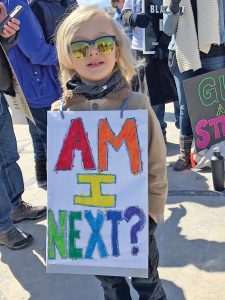First in a special Baltimore’s Child series on school safety
 Not long after the February shooting at a high school in Parkland, Florida, there was a threat against Mary Stovenour’s middle school in Carroll County. The online threat was not real, it turns out, and the school’s principal quickly reassured students, teachers and families. But Mary says she couldn’t forget the anxiety she felt that day.
Not long after the February shooting at a high school in Parkland, Florida, there was a threat against Mary Stovenour’s middle school in Carroll County. The online threat was not real, it turns out, and the school’s principal quickly reassured students, teachers and families. But Mary says she couldn’t forget the anxiety she felt that day.
The point of childhood, the 13-year-old says, is “to be at school, to learn and to be with friends” and not to wonder “every time you enter a new classroom where you will hide from a shooter.”
Moved to prevent other kids from experiencing the fear she did, Mary and her grandmother, Janis DiSibio, a retired social worker from Taneytown, attended the March for Our Lives in Washington, D.C. in March. Mary is hopeful the effort will lead to a ban on civilian ownership of military-style weapons. Her grandmother wants to see increased and improved background checks; she has encouraged her granddaughter to stay politically involved, “to keep the pressure on and be consistent.”
Mary agrees, “Kids should not have to feel unsafe in their schools anymore.”
Across the state, and in Mary’s own school district, security teams, administrators, counselors, teachers and others have been collaborating to figure out the best ways to make today’s schools safe from gun violence, intruders and other dangers.
Since mid-March, armed school resource officers have added a layer of security to Carroll County Public Schools, rotating among the system’s 40 schools, says Duane Williams, supervisor of security and emergency management. Prior to that, the school system did not have a regular police presence.
“It’s been very helpful,” Williams says, adding that good communication with local police agencies is essential for school systems. The positions are approved for the county’s school system next year, but not yet funded. Williams is hopeful, but says there are other measures schools should take, too.
(In April, the Maryland General Assembly passed a law that requires schools without SROs to work with local police on a response plan.)
In the wake of the Parkland shooting, county parents have done a good job of sharing information that concerned them as well as potential threats. This trust and communication need to continue, he says.
“It would be impossible for me to say we care about their kids as much as they do,” Williams says. “But not one of us wants to see a kid injured in one of our schools. We take our responsibility seriously.”
More understanding of mental health issues is also needed, Williams says. Under current county rules, if a student makes a threat against a school, he or she must complete a mandatory violence assessment before returning to school, he says, adding that following up with needed resources after those assessments has to be consistent, too.
“Just about every school system is learning that we need to be better in that arena,” he says.
Another focus: Internal threat assessment. In many school systems, such as Carroll County, personnel like Williams will work with local police to determine if a threat against a school is credible. But even before a threat is made, there are often signs that a student is experiencing mental health or other issues. Teams within a school can be trained to better identify students in need of help — and identify them earlier. In fact, Williams attended a training session last month that addressed this issue.
For their part, parents can “be situationally aware of what’s going on with your child,” William says. Pay attention to violent media they are watching, for example, or other troubling signs. Parents “might find that offensive,” he admits, but the situations that have led to school shootings “didn’t happen overnight.” There are often opportunities for parents and school officials to step in and help a student who needs it, he says.
Like Mary and her grandmother, he believes now is the time to make changes and to add new protocol.
“There is a hypervigilance right now with parents and students. They are very tuned in to school safety,” he says.
Statewide support
Driving back from Annapolis one day late in the legislative session, Ed Clarke, executive director of the Maryland Center for School Safety, echoes the sentiment. “We hear the angst of parents. These times are very challenging for parents, students and staff,” he says.
But there are also a lot of programs in place. The center was created in 2013 after the school shooting in Newtown, Connecticut and is an independent agency that works with Maryland State Police, Maryland State Department of Education (MSDE) and local jurisdictions. Weekly, Clarke holds a conference call for school resource officers, other safety personnel, local police officers and others across the state to talk about incidents in their school districts and to share best practices.
Earlier this year, an officer from a Fort Worth, Texas school received information that a student there was planning a shooting — and a student somewhere in Maryland was involved. The Texas officer reached out to a Maryland school officer who alerted everyone from the weekly group; within a half hour, both students were located.
“It was clear that we did interrupt a serious plot to schools in Texas and in Maryland,” Clarke says. “It saved lives.”
Also important: “Both students were able to get the help they needed,” he says.
The center is currently working with the MSDE to develop a protocol to help school personnel “understand what someone is going through if they are on a path to violence.” The protocol will eventually lead to mental health training that individual school districts can tailor to fit their communities.
Clarke is big on models, best practices and letting school leaders figure out for themselves what works best in their districts. He supports SROs as well as intercoms and other systems that prevent open access to a school. He’s also not sure metal detectors are a good option for many schools (“Do the research.”), and agrees with Gov. Larry Hogan’s stance not to arm teachers with guns.
“Teachers signed up to be teachers. They didn’t sign up for quasi-law enforcement,” he says.
Clarke also is sympathetic to the anxiety Mary experienced over the false threat at her school and says social media can cause problems in these tense times. Parents can make a big impact by impressing upon their children not to repost threats, he says. Instead, they should immediately share them with a parent or adult at school.
Safety is a community effort, he says. But that’s how it should be. “If we wanted to, we could make our schools fortresses,” he says. “But I don’t think that’s what we really want.”









